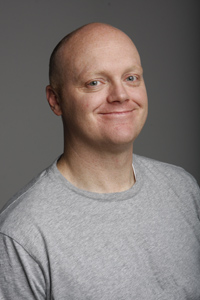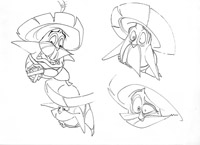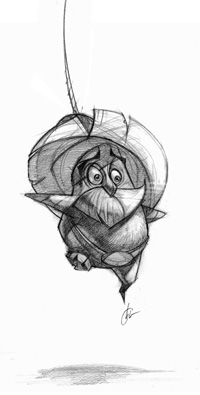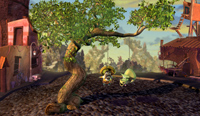Kelly Loosli

What is your background with animation and film?
I made my first animated film when I was eleven. Then when I was fourteen, I made a little clay-animated film. I was having it transferred to video when an advertiser saw it, a man by the name of Richard Paul Evans (people know him because he wrote The Christmas Box). When I was fifteen, I started working for him doing low-budget clay animation commercials. I came to BYU and my sophomore year I made a short film called Nocturnal that won a student Emmy.
After I graduated I moved to Los Angeles and got a job at DreamWorks. I was over the sculpting/character design department for the original Shrek, mostly as a coordinator but I also got to do some sculpting. I worked there for about two years, then left to go work for the live action division of Disney, which is called Buena Vista. Then my father-in-law died. We moved back to Utah and I ended up working for Feature Films for Families in Salt Lake.
Back when I was a student at BYU, one of the industrial design faculty, Brent Adams, told me he was teaching a 3D class and that I could come take it. I took his class and when I came back to Utah, he recruited me to teach. I taught a class for the film program in ’99. Then in 2000, I got hired to help create the animation program, and I’ve been here ever since.

Can you tell us more about the formation of the animation department?
It was Brent Adams, an illustration faculty named Richard Hull, and an associate dean named April. They had seen that within a ten-year period there were a bunch of students—industrial design students, film students, illustration students—all making animated films, despite the fact that BYU wasn’t really supporting it. And a lot of them were already getting placed out in the industry; some guys were at Digital Domain, some at Disney, some at DreamWorks.
So they got approval in 2000 to see what we could do to put together a curriculum. We put it together and sent it up the ranks to get approved. It was unheard of, but it got approved first pass. The dean here was Newell Dayley, who had experienced a similar thing—when Newell was teaching music at BYU, jazz wasn’t permitted on campus. Newell and others said, “Jazz isn’t inherently bad,” and they finally got jazz approved and showed what a great thing it was, so he was very supportive of faculty being innovative.
Newell moved me over from the Visual Arts department into the Theatre and Media Arts Department. Then we found Ryan Woodward, who came in the second or third year when the program was officially approved. They didn’t want us to add a ton of classes, so we found classes in other departments and tried to see how all those could add together to give students a broad experience. Students were taking their 3D classes from Industrial Design, they were taking all their core art classes from Visual Arts, they were taking all their film and film history classes from Theatre and Media Arts, and that’s how we built the program.
We took my experience from industry first and said, “Let’s imitate what industry is doing.” We started making those group films and they started winning awards, and that’s what brought us the initial attention and got us approved. And then there were people like Visual Arts faculty who were really supportive and would let our kids into their figure drawing classes. Darl Larsen, who is a film history teacher, started teaching the animation history course for us. Everybody just kind of pitched in—they’re all equally to blame for the success of the program. Although it’s just three core faculty, if you expand that out to who’s actually teaching our students, it’s truly interdisciplinary: two colleges and three departments.
We just hired away Cynthia Overman, the head of the character animation department at CalArts, which is the school Disney created. And we’re hiring another faculty member, which takes us to five. We’re also currently trying to revise the program. When we first created it, it was all about, “How many openings are in these classes and are they of value?” Now, without ruining what we’ve already done to be successful, we’re going to try to figure out if this is the best method for helping students, or if there’s a better curriculum we can create from scratch now that we have enough faculty to support it.
And then the Center, which was created last year, has given us these two new faculty spots. And the Computer Science department is now an active part of the center.

How did the Center get started?
First of all, interdisciplinary programs are really hard to administrate. Between three departments and two colleges, it’s a lot of work. There needed to be some way to have some control so that if one of the deans in one of the colleges decided to change things, it wouldn’t mess everything up for everybody else. They decided that a center would be a good way to bridge colleges—like the Kennedy Center.
At the same time, the University of Utah and Arizona State were trying to recruit Brent and me away, and studios and some other schools were trying to recruit Ryan. All of that came to the attention of BYU and they said, “Look, we want this program. Let’s do this.” And they did. They got two deans together to oversee the thing and created the Center.
While that was happening, Computer Science said, “You guys have been placing our students; we want in. What do we need to do?” For years we’d been having their students work on our films, in an unofficial capacity, and we were having a lot of success—we were placing their kids at DreamWorks and Pixar. So they just jumped in.
What do you think is the key to the success of the animation program?
Our students really put in a ton of time. They live in the labs. Although they only get a BFA out of the program, they’re basically putting in the time to get an MFA.
We also emphasize group, collaborative projects versus independent projects. We do emphasize individual artistic development, but when we make our big projects, they’re all group projects, and that simulates what they’re going to find out in the real world. Because of that, they’re really easy to transition. When Ed Catmull (founder and president of Pixar) was here in the spring, he said that one of the things he likes about BYU students is that there’s no ramp-up time—they can come out of school and go right into production because our system is set up exactly like what they do in industry.
The other thing I would say is that the faculty put in a ton of time. They’re not your 9–5 faculty. You’ve got Brent, myself, Ryan, and Cynthia just started but I know she’s this way too, where we’ve been giving up our summers—when we’re not getting paid to be here—and we’re here working with students, we’re on the phone, we’re shooting emails at nights. All of us have done a lot of through-the-night shifts working on films with students. We really emphasize mentoring, probably more than normal academic teaching. And as soon as students see that faculty are putting in that much time, they end up putting in a lot more time.
Why the passion?
Our mission statement is to place as many values-based people into the entertainment industry as we can. I think that most people who are in media of any sort know that somewhere along the line they saw some films that really impacted their life. You realize how powerful media can be, and then you think about your own testimony and experiences. And in my case or in Ryan’s case, you go, “Man, I work with a lot of sleazeballs or a lot of weirdos, and I’ve got little kids—I don’t want them deciding what types of products are being made. I’d rather have values-based people.” You see a lot of people where it’s their testimony that hooks them into the greater vision of what can actually be done.
A lot of people are motivated occupationally just by fear—they just want to make a good living. And our students do make a good living, but I think most of it is that greater idea. Maybe it’s missionary work, maybe it’s being involved in something that will affect people’s lives. At least that’s the way it is for me, and I know it’s the same for the other faculty.

How do you see the gospel and values in general influencing your animation and your films?
When we first started making movies, our movies were fairly Warners Brothers-esque. I don’t want to say violent, because it’s not like there was blood splattering, but they were pretty aggressive movies. As we’ve honed our skills and talents and tried to help students broaden their minds, however, we’ve moved into some different storytelling. We’re making a movie right now called Kites, which is a story about a Chinese-American boy whose grandfather dies. While he’s mourning the death of his grandpa, his grandpa shows up out on the fire escape of his apartment building. He follows his grandpa up to the roof and finds him flying these Chinese kites. The grandpa gives the boy one of the kites, it pulls him up into the sky, and they have this whole adventure in the sky on these kites. He gets a kind of last hurrah, and then Grandpa walks off into the sunset in the clouds and the boy takes off on his kite.
That’s a pretty ethereal sort of spiritual story, and the students are starting to grasp that, “Hey, we need to say something, we need to have a value.” We brought in a Dutch animation director who won an Academy Award for some fairly spiritually based stuff, and his whole visit is what inspired these kids to do something more along these lines. You see more and more of that thing happening. At the same time, these students are just learning how to tell stories, and there’s a lot to it.
How do you see animation and film building the kingdom?
I think I came to love animation because my dad was able to take the basic animated films I was watching and use them to help me understand gospel concepts. Pinocchio became a big film for me because my dad could teach me about listening to the Holy Ghost. Just as the Savior taught using parables, it’s also a way to teach hard concepts. Stories are such a powerful part of human existence.
We’re competing against people with billions of dollars making media. I have a lot of friends who are homosexuals, so I don’t want this to be slanderous, but after the TV show “Will and Grace” came out, look at how people felt about homosexuality. Why aren’t Church members doing more to create product that helps sway people in another direction? Shortly after Napoleon Dynamite and New York Doll came out, one of the original MTV VJs, Kurt Loder, wrote an article about how the BYU film program was turning out people who were really in touch with the power of innocence and goodness. This is from a cynical, jaded New Yorker who doesn’t care, he’s not a values-based person, but he’s saying that this could be the new wave of film because these people have tapped into something that is neat and unique and fresh. And you see that we can touch even the most jaded people.
There are so many ugly things out there that we should be creating beautiful art, doing stuff that testifies of God’s creations. There’s so much we can do with it that isn’t currently being done. Animation is cool because you can create all the worlds you want, or you can just imitate the beautiful world we live in. You can take people places they can’t ordinarily go. If you can get enough positive media out there, it can influence people regularly. That’s the greater vision.

With placing the animation students out in industry, how did those connections develop?
We were making these films and people started seeing them at festivals. At the same time, our students were sending their demo reels out, and people would see their reels, hire or intern one of our students, and then get hooked on BYU students. Digital Domain hired one LDS guy and were totally impressed with him, so they brought on another and then another.
We placed a kid who wasn’t even in our program, a computer science student who had worked on three films with us. He sent in his demo reel and one of the guys who’s been at Pixar since it started, Eben Ostby, watched it and was blown away. He said, “We brought him in as an intern, then we realized that he was the easiest guy to work with. He was super nice and was really teachable, so we told him to let his friends know to apply.” We’d already been in touch with Pixar because Ed Catmull is a Utah guy, raised LDS, and Ed said, “Go make a trip out there.” So the Human Resources people came out here to recruit, and we did our little dog and pony show and they said, “This is the most amazing thing.” And they just started coming out regularly.
As soon as they saw that we were a fourth of their entire internship program, Ed finally just said, “Okay, we’re going to get officially involved with them.” One of the guys who isn’t LDS but was raised in Salt Lake said, “I want to be in charge of them. I love Utah and I think these guys are awesome.” He was put in charge of us as a school, and so he comes out twice a semester. The program’s not that old, but over the course of two years they’ve recognized us and all of a sudden we’re partners.
George Lucas’s company, ILM, hired some students. The guy who set up the head for Davy Jones on Pirates of the Caribbean, Jason Smith, is a BYU grad. He was written up as one of the top ten people in the effects industry under 35 to watch. They had the same experience—one person after another started getting placed there, and they said, “These guys are awesome.”
Almost all of the modeling department at DreamWorks are former BYU guys. It’s the same as anywhere—people want to hire their friends or like-minded people, and you start to see these little cultures sprouting up. As soon as other studios found out how much DreamWorks and Pixar were recruiting us, they decided they had to come check us out.
Our films have been a good benefit for the students, but it’s also the students’ work ethic. When they get out in the industry, they’re such good examples that that’s what opens up the doors. They’re the nicest people. You don’t have BYU grads coming in hung over; they’re not stepping out for smoking breaks, so they’re more productive. That’s not to say there aren’t jerks here, because we do have our share of jerks in the program. But by and large, people recognize the quality of the people BYU turns out and they love it.

What’s the process of putting together one of these student films?
At the beginning of the students’ junior year, we have an open pitch, where they come and present their idea to the junior class. They all pitch ideas, and then the juniors vote. What typically happens is they go away with the one idea, then they come back with different versions based on that same idea. They repitch it, vote on it, and then start doing concept art and storyboards. In the winter semester of their junior year they vote on which student they want to be their director, which they want to be their producer, and who’s going to do what. If there are voices, they record the voices. Then through the spring and summer they build the models. The next year they animate it, light it, and render it. They all know that in industry they really only do one thing, so they focus on that one thing on the senior film. They help out in other areas to make sure the film gets done, but they get to become an expert at that one area. And that’s it. It’s about an eighteen-month process. When the film’s done, we finish it up and make copies and start pumping them out to festivals and competitions.
We run it a bit like priests quorum—I’ve been in the priests quorum nine years—where the whole idea is to get the boys to actually run the quorum. It’s the same here. When studios come to visit us, we as faculty tour the people around and then sit in the back of the room while the students give the presentation to the studios. They run their own show. They set their own schedules. We facilitate equipment; we give feedback; we break up fights; we weigh in if we think they’re going down the wrong path; we advise; and we’re there all the time, but we essentially let them run the process.
The animation program and field are both very competitive. What advice do you have for people interested in getting in?
We teach our prerequisite courses to 130–150 students a year. Out of those, ninety will apply, and we accept twenty-five. The key to getting into our program is drawing the human figure. Once you’re in, take advantage of the cutting-edge technology readily available to undergraduates here. We have access to the supercomputer and other high-end rendering solutions that other schools don’t have.
At that point it’s about students just spending the time and trusting the faculty. Students who don’t let obstacles hold them back but put in the time and develop a strong core set of skills—usually one skill that’s really technical and one skill that’s strongly artistic—are the people we place. We have over 90% placement, and our kids on average rival the highest paid graduates of BYU.
Because they’re getting university experience, their skill set and their knowledge set is so much broader than kids coming out of an art school that it seems to give them longevity in the industry. Learning is a part of who they are, so they can learn and adapt and grow. That’s what keeps you fresh and viable in the industry. I’d say that’s probably the same as with the gospel—as soon as you’re not teachable, you’re toast.

Where do you see the animation program going in the future?
We’re hoping to expand it by creating a minor so all these other programs that have helped build our program—illustration, photography, fine arts, media arts, theatre, industrial design—can come participate with us. That way we can leverage their students to flood the market, with the idea being that we want to get as many of these values-based people out there as we can. And we know that all these other programs here are teaching the same sound artistic fundamentals and then backing that up with spiritual content. We can easily see our program doubling its reach in terms of placement of students. We hope as we push and grow that we’re going to start to place students in more creative positions, too, and eventually start to see people who’ve come out of our program in producer and director roles. Those are the people who are going to make the impact we’ll see directly. Everybody makes an impact based on their work ethic and their good example, but we think there are some Brad Birds and some John Lasseters and some Walt Disneys and some real leaders in among the kids we’re teaching. ❧
